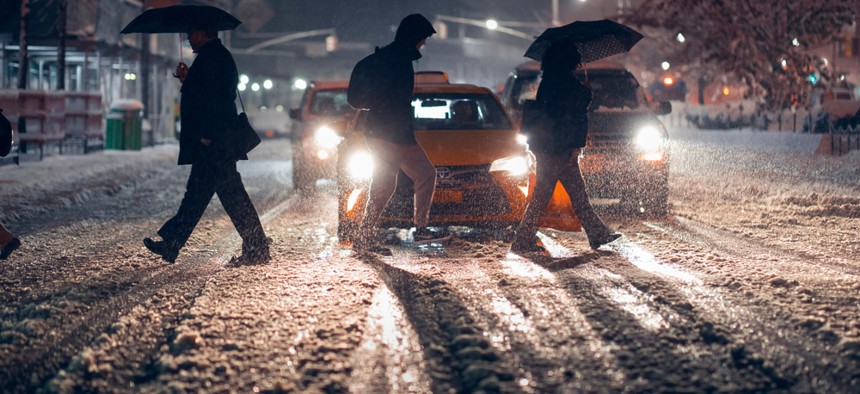Bill de Blasio
Who’s to blame for Thursday’s snow-fueled gridlock?
Who’s to blame for Thursday’s snow-fueled gridlock? Agencies are quick to deflect blame following severe commuter delays.

Snow in New York City Michelle_C/Shutterstock
The snowfall that blanketed New York City during rush hour on Thursday evening stalled traffic on several bridges, clogged streets on both sides of the Hudson River and kept commuters at the overcrowded Port Authority Bus terminal and other points in the city waiting for hours to get home.
And while more snow fell on the city than had originally been forecast, many frustrated New Yorkers wondered how a seemingly manageable situation had spiraled out of control.
The New York City Department of Sanitation, which is responsible for salting and plowing the city’s streets, pointed to the bridge closures, including on the busy George Washington Bridge. The Port Authority of New York and New Jersey, which manages the George Washington Bridge, blamed the gridlock on unplowed streets on either sides of their tunnels and bridges – implicating the city Department of Sanitation and the New Jersey Department of Transportation. The Metropolitan Transportation Authority claimed that its subways and commuter lines had performed well, but that its buses had also been impeded by accumulating snow on the city’s streets.
“It’s like everybody sits in a circle and they all point to the right as it goes around in a circle,” said Dr. Robert Paaswell, a former executive director of the Chicago Transit Authority and a current professor of civil engineering at the City College of New York.
The New York City Department of Sanitation’s biggest challenge was the George Washington Bridge closure, which caused many highways and streets to back up, according to an agency spokeswoman. “Complicating issues was the fact that several bridges were closed and traffic, particularly in the Bronx, upper Manhattan and on Staten Island, came to a halt with our snow clearing equipment stuck within,” Director of Communications Belinda Mager said in an email. “Tree branches also snapped from the weight of the snow, blocking many streets.”
Magers said the city deployed its salt spreaders early on at key points, but the second wave of defense – snow plows – were stuck in backed up traffic like everyone else.
Because of the congested roads, many buses simply couldn’t reach the Port Authority Bus Terminal. With so few buses taking passengers away, the Port Authority blocked access to its second and third floors. The line of people waiting to get into the terminal reportedly spanned an entire block. By 5:30 p.m., Port Authority officials were advising commuters to utilize trains or ferries.
Steve Coleman, a Port Authority spokesperson, attributed the gridlock to unplowed streets on either sides of their tunnels and bridges, which is the responsibility of the city Department of Sanitation and the New Jersey Department of Transportation. Coleman also said drivers were responsible for the George Washington bridge pile-up that resulted in the closure of the bridge’s top level. He also cited one especially slow driver on the Bayonne Bridge, which only has one lane in each direction currently, for the backup and eventual closure on that bridge.
The Metropolitan Transportation Authority did everything it could and should have done to prepare, said MTA spokesman Shams Tarek. Buses were equipped with all-weather tires and de-icer trains were deployed. Tarek reported that the Long Island Rail Road, Metro North Railroad and the subways all performed well given the challenging conditions. The problem for the MTA was the gridlock on the roads.
“Our buses were held hostage to massive gridlock citywide,” Tarek said. “Our bus operators and front-line employees fought through epic traffic and kept the subways moving – and we’re grateful for their dedication during a tremendously difficult commute.”
On Friday, the major agencies involved promised to reach out to each other to review what happened. However, experts said there should be better communication beforehand, as well.
“You need better coordination and certainly much better coordination while the event is occurring,” Paaswell said. “Like it looks like we’re going to have trouble on the bridge, stay away from the bridge, etc.”
Of course, while forecasts predicted a few inches of snow and then rain and temperatures in the forties, the temperature plummeted and five to six inches fell on New York City right before rush hour on Thursday. Tree branches fell and closed streets, and schools and businesses all let their students and workers go home at the same time. One domino after another tipped and it created the perfect storm of catastrophes for a city that had weathered storms five times the size.
New York City Mayor Bill de Blasio said nobody is to blame for the problems. After being asked during a press conference Friday afternoon whether he owes New Yorkers an apology like the one New York City Council Speaker Corey Johnson posted on Twitter, de Blasio said, “I’m upset that New Yorkers went through it. I don’t think it’s fair to say the city agencies could have stopped all of this. People want to blame city agencies on something they literally could not have stopped. I’m not going to be a part of that.”
Paaswell didn’t blame the mayor, but he noted that “snow storms bring down more mayors than any other event.”
“One of the things you have to realize is sometimes God doesn’t want people to travel,” he said. “And the idea is sometimes things are totally out of your hands but you have to be prepared for them.”

NEXT STORY: How state lawmakers could get a salary hike in January